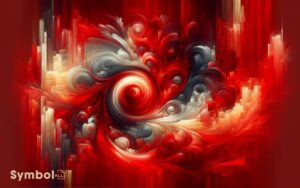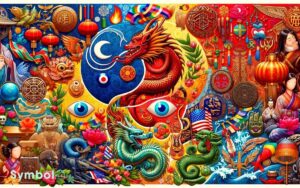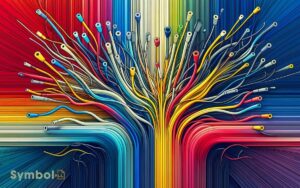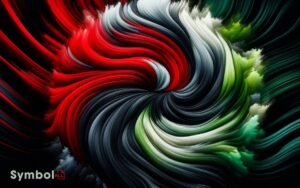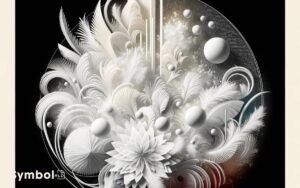What Does the Color Yellow Symbolize in the Great Gatsby
In “The Great Gatsby,” you’ll find yellow symbolizing the allure and corruption of wealth. It’s the color of both opulence and the moral decay it brings, painting a vivid picture of the American Dream’s darker side.
Yellow also highlights the illusion of happiness that wealth promises, only to reveal the hollowness beneath.
Characters are draped in or surrounded by yellow, showcasing their moral degradation and the emptiness of their extravagant lifestyles.
Tragically, yellow foreshadows death and destruction, leaving a trail of decay in its wake. Exploring further, you’ll uncover deeper insights into how these symbols craft the novel’s critique.
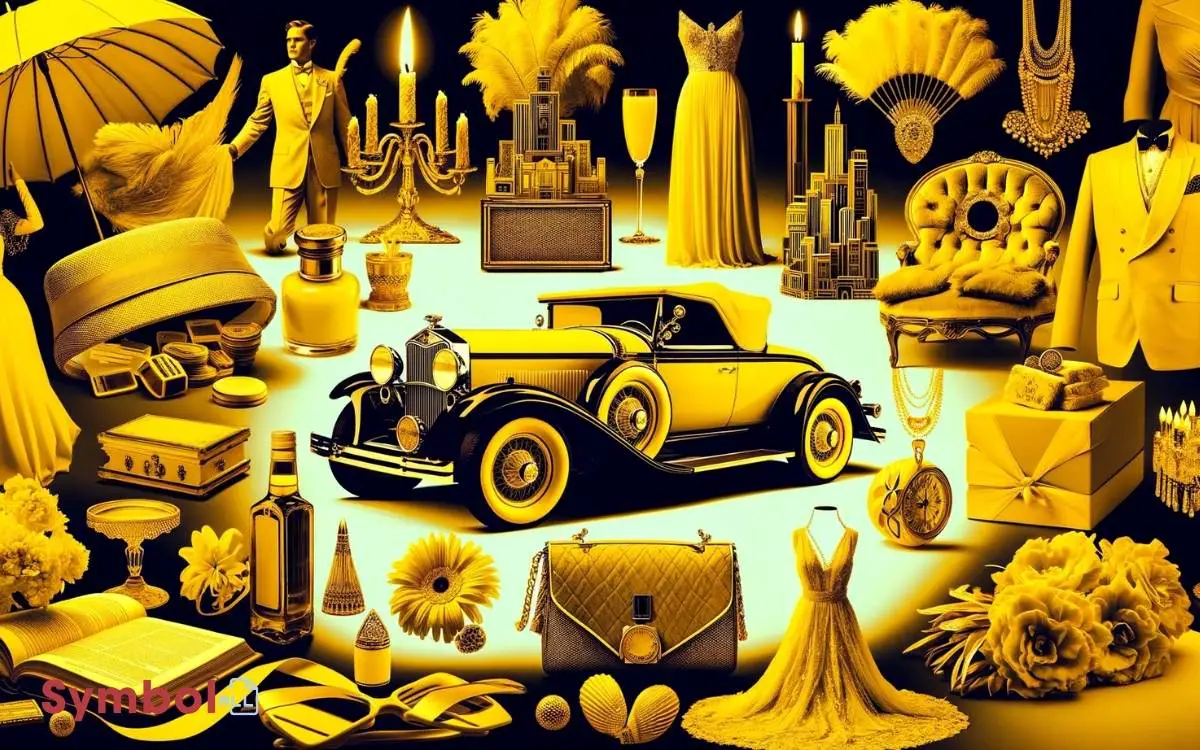
Key Takeaway
The Allure of Wealth
In F. Scott Fitzgerald’s ‘The Great Gatsby,’ the color yellow vividly captures the seductive allure of wealth, embodying both its dazzling promise and perilous facade. Yellow is often used to depict the glitzy yet superficial world of the nouveau riche, masking the emptiness that lies beneath their opulent lifestyles. Contrasted with the green symbolism in The Great Gatsby, which represents Gatsby’s unattainable dreams and the hope for a brighter future, yellow reminds readers of the corruptive and fleeting nature of material wealth. Together, these colors weave a complex tapestry of aspiration, illusion, and moral decay in Fitzgerald’s iconic narrative.
This symbolism is meticulously woven into the narrative, where you’ll notice yellow not just as a mere backdrop but as a critical commentary on the era’s material obsession.
Fitzgerald uses yellow to highlight the superficial glamour and the underlying corruption of the American Dream.
You see it in the opulent parties at Gatsby’s mansion, the gleaming vehicles, and not least, the spectacles of Daisy, the golden girl herself.
Through these images, Fitzgerald isn’t merely painting a picture; he’s inviting you to look beyond the surface, to see that the pursuit of wealth often masks a deeper moral decay.
Illusions of Happiness
Yellow’s pervasive presence in ‘The Great Gatsby’ not only underscores the allure of wealth but also crafts a vivid tapestry of happiness’ illusions, masking the emptiness that festers beneath.
This hue, bright and inviting, symbolizes a façade of joy and fulfillment that characters desperately cling to, ensnaring themselves in a web of deception.
You observe Gatsby’s lavish parties, awash in golden light, projecting an image of perpetual celebration.
Yet, beneath this shimmering surface lies a profound loneliness and a yearning for something more authentic, more meaningful.
Through yellow, Fitzgerald masterfully reveals the hollowness at the heart of the American Dream, cautioning you against mistaking glitter for gold.
It’s a poignant reminder that true happiness can’t be fabricated or bought, but must be found in genuine connections and experiences.
The Corruption of the Dream
As you explore the motif of yellow in ‘The Great Gatsby’, you’ll uncover its critical role in illustrating the corruption of the American Dream.
Fitzgerald uses this color to highlight Gatsby’s tainted ambitions, the hollow promise of wealth, and the inevitable destruction through excess.
This analysis reveals how the allure of opulence conceals the decay and moral bankruptcy at the heart of the dream.
Gatsbys Tainted Ambitions
Why does Gatsby’s pursuit of the American Dream, symbolized through the pervasive use of yellow, ultimately reveal the inherent corruption and unattainability of his ambitions?
This question probes deep into the heart of Fitzgerald’s narrative, exposing the gilded facade that Gatsby constructs around himself.
Yellow, a color traditionally associated with wealth and prosperity, ironically becomes a harbinger of moral decay and disillusionment in Gatsby’s world.
- Yellow’s Dual Nature: Reflects both the allure and the peril of Gatsby’s aspirations.
- Gatsby’s Car and Parties: Ostentatious displays that mask the emptiness of his achievements.
- Daisy’s Role: Represents the unfulfilled promise of happiness, cloaked in the very same golden light that fails to bring Gatsby contentment.
Gatsby’s tainted ambitions serve as a cautionary tale, underscoring the complexities and pitfalls of the American Dream.
Wealths Hollow Promise
Exploring further, the narrative reveals how the pursuit of wealth underpins the corruption of the American Dream, showcasing its promise as ultimately hollow and deceptive.
Through Fitzgerald’s lens, you see that the gleaming surface of wealth, often symbolized by the color yellow, conceals a deeper void.
This hue, while initially emblematic of prosperity and joy, gradually exposes a darker reality. The characters, entranced by the allure of affluence, find themselves ensnared in a web of disillusionment and moral decay.
The yellow car, a glaring symbol of Gatsby’s wealth, becomes a vehicle of tragedy, underscoring the perilous path of those seduced by the dream’s gilded facade.
This portrayal critiques the era’s materialistic values, suggesting that the pursuit of wealth for its own sake leads to spiritual bankruptcy.
Destruction Through Excess
In F. Scott Fitzgerald’s The Great Gatsby, the theme of destruction through excess serves as a critical examination of how the American Dream becomes corrupted, showcasing that beyond the seductive lure of boundless prosperity lies a path to moral and spiritual ruin.
- The lavish parties at Gatsby’s mansion symbolize the decadent excess that leads to isolation rather than genuine fulfillment.
- Daisy Buchanan’s choice, driven by material wealth over true love, illustrates the moral compromises that accompany such excess.
- The tragic end of several key characters underscores the ultimate price of living a life defined by overindulgence and the pursuit of superficial success.
Decay Beneath the Gold
Exploring the symbolism of yellow in *The Great Gatsby*, it’s crucial to recognize how Fitzgerald uses the hue to reveal the decay beneath the surface of the era’s prosperity.
The gold that initially symbolizes wealth and success soon peels away to expose gilded facades masking profound corruption.
This shift underscores the illusory nature of the American Dream, suggesting that what glitters isn’t always gold.
Illusory Prosperitys Dark Side
Beneath the glittering facade of prosperity in ‘The Great Gatsby,’ lies a profound decay, revealing that the pursuit of wealth often masks a deeper moral and societal rot.
Fitzgerald masterfully uses the color yellow to symbolize this illusory prosperity and its dark side, where the quest for material riches leads to moral bankruptcy and personal desolation.
- Yellow cars and dresses: Ostentatious displays of wealth, hinting at the emptiness and corruption that lies beneath.
- The eyes of Dr. T.J. Eckleburg: A god-like judgment on the characters’ moral decay, overlooked by society.
- Gatsby’s parties: Superficially dazzling yet fundamentally hollow, mirroring the empty pursuit of the American Dream.
This symbolism serves as a poignant critique of the American Dream’s promise of prosperity, revealing the dark underbelly of its pursuit.
Gilded Facades, Hidden Corruption
Fitzgerald’s meticulous use of gold not only enhances the narrative but also exposes the pervasive corruption hiding behind the era’s gilded surfaces.
You’ll notice how the allure of wealth contrasts starkly with the moral decay it masks. This dichotomy is critical to understanding the novel’s deeper themes.
| Symbol | Interpretation |
|---|---|
| Gold Cars | Ostentatious wealth masking irresponsible behavior |
| Gilded Parties | Superficial joy concealing deep unhappiness |
| Golden Objects | False idols representing empty values |
| “Golden Girl” Daisy | Beauty and charm hiding selfishness and moral bankruptcy |
Through these symbols, Fitzgerald critiques a society obsessed with surface-level beauty, ignoring the rotten core beneath.
By engaging with this facade, you’re invited to reflect on the cost of such deception, both personally and socially.
Moral Degradation
In The Great Gatsby, the prevalent use of yellow not only symbolizes wealth and glamour but also highlights the characters’ moral degradation, illustrating how material excess leads to ethical decay.
- Yellow cars and dresses symbolize not just affluence but reckless abandon and irresponsibility.
- The golden spectacles of T.J. Eckleburg serve as a divine witness to the era’s moral corruption, observing yet unable to intervene.
- Gatsby’s extravagant parties, drenched in yellow light, mask the emptiness and superficiality of the attendees’ lives.
This color, often associated with joy and energy, becomes a tool to peel back the layers of the Roaring Twenties, revealing a world where the pursuit of wealth corrodes the soul, leaving behind a barren landscape of broken dreams and lost integrity.
The Unseen Observer
Shifting our focus, we observe that The Great Gatsby employs the motif of an unseen observer, subtly weaving throughout the narrative to underscore the theme of surveillance and judgment in a society obsessed with surface appearances.
This unseen observer isn’t merely a passive witness but serves as a mirror to the characters’ true selves, hidden beneath layers of pretense and decadence.
It’s through this lens that you’re invited to scrutinize the ethical and moral vacuums that define the lives of the characters, highlighting the dissonance between their public personas and private realities.
This constant surveillance acts as a silent critic, emphasizing the superficiality that pervades the novel‘s setting, and challenging you to question the true worth of the characters’ opulent, yet ultimately hollow, lifestyles.
Death and Destruction
Amid the glittering excess of Gatsby’s world, one can’t overlook the dark undercurrents of death and destruction that ultimately define the narrative’s trajectory. Yellow, a symbol of decay beneath the golden surface, becomes a harbinger of these grim themes.
- The yellow car, an emblem of Gatsby’s wealth, directly leads to Myrtle’s tragic death, intertwining luxury with mortality.
- Gatsby’s gold-tinted spectacles reflect a distorted perception, blinding him to the reality of his own demise.
- The fading yellow of the once-vibrant leaves mirrors the inevitable decline and fall of Gatsby’s empire, foreshadowing his own end.
This color’s dual symbolism exposes the fatal flaw in the American Dream, illustrating how aspirations of wealth and beauty often mask the impending doom lurking beneath.
Conclusion
In ‘The Great Gatsby,’ yellow isn’t just a color; it’s a siren song of wealth that, like the Midas touch, corrupts everything it graces. Consider Gatsby’s car, a golden chariot that ultimately drives him to his demise.
This emblem of luxury becomes a harbinger of death, illustrating how the pursuit of an opulent facade leads not to fulfillment but to moral decay and destruction.
Yellow, thus, embodies the perilous allure of a dream tarnished by greed, serving as a cautionary hue against the seduction of superficial splendor.

